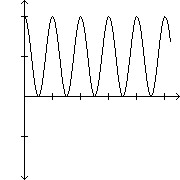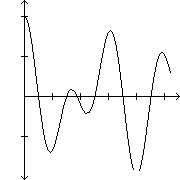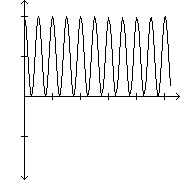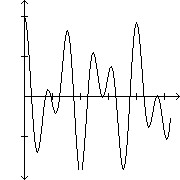The displacement d (in meters) of an object at time t (in seconds) is given. Describe the motion of the object. What is the maximum displacement from its resting position, the time required for one oscillation, and the frequency?d = 4 cos (5t)
A. simple harmonic; 4 m;  ? sec;
? sec;  oscillations/sec
oscillations/sec
B. simple harmonic; 4 m;  sec;
sec;  ? oscillations/sec
? oscillations/sec
C. simple harmonic; 4 m; 5 ? sec;  oscillations/sec
oscillations/sec
D. simple harmonic; -4 m;  ? sec;
? sec;  oscillations/sec
oscillations/sec
Answer: A
You might also like to view...
Find the x-intercepts for the parabola whose equation is given. If the x-intercepts are irrational, round your answers to the nearest tenth.y = x2 + 4x - 7
A. x-intercepts: none B. x-intercept: (4, 0) C. x-intercepts: (-2 ± 3.3, 0) D. x-intercepts: (-4, 0) and (3, 0)
Solve the problem.If a tone is formed from the combination of two component frequencies, F1 and F2 , as is done with touch-tone phones, then the tone can be represented as  if the intensities of the components are equal. For the two component frequencies
if the intensities of the components are equal. For the two component frequencies  and
and  rewrite this expression as a product of trigonometric functions and graph the result in
rewrite this expression as a product of trigonometric functions and graph the result in  -4.0px;" /> by
-4.0px;" /> by 
A. 2 cos(995?t) cos(995?t)
[0, .005, .001] by [-2, 2, 1]
B. 2 cos(995?t) cos(265?t)
[0, .005, .001] by [-2, 2, 1]
C. 2 cos(1990?t) cos(1990?t)
[0, .005, .001] by [-2, 2, 1]
D. 2 cos(1990?t) cos(530?t)
[0, .005, .001] by [-2, 2, 1]
Solve the problem.Lisa stashed in an envelope on her dresser $454 each week for 9 weeks. Estimate the total amount she saved by rounding the weekly amount to the nearest hundred. Also find the exact amount she saved.
A. Estimate: $4,500; exact: $4,050 B. Estimate: $4,050; exact: $4,086 C. Estimate: $4,050; exact: $4,050 D. Estimate: $4,500; exact: $4,086
Factor the trinomial completely. If the trinomial cannot be factored, say it is prime.m2 + mn - 56n2
A. (m + 8n)(m - 7n) B. (m + 8n)(m + 7n) C. (m - 8n)(m + 7n) D. (m - 8n)(m - 7n)